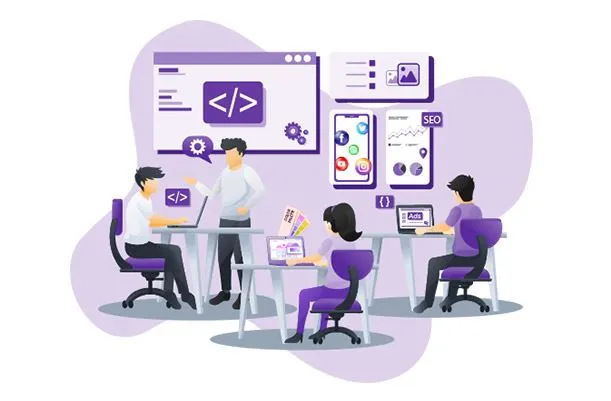What Is Web Software Used For?
Software is a set of commands that enables computers to perform specific tasks, and web software is the extension of this process into the online environment. Thanks to web-based software, users can carry out their operations through a browser without needing to install any program. These systems allow businesses to address needs such as customer management, sales, reporting, and reservations in a centralized and accessible way.
The biggest advantage of web software is that it can operate independently of location and be easily integrated into multi-user systems. Software supported especially by cloud-based solutions offers businesses significant advantages in terms of both cost and time. At the same time, update, maintenance, and data backup processes become much more practical.
Web software that can be developed specifically for virtually any business, from a small startup to a large-scale enterprise, improves the user experience and accelerates digital transformation processes. Used in many different areas—from order systems to inventory tracking, from education platforms to appointment systems—this software streamlines business processes and increases efficiency.
What Are the Differences Between Web Applications and Static Websites?
Web applications are software systems that can interact with the user, deliver dynamic content, and exchange data. In contrast, static websites present pre-prepared content in the same way to every user. While user experience remains passive on static sites, web applications can produce personalized responses. This distinction clearly separates the two structures in terms of both technical infrastructure and intended use.
Key differences between web applications and static websites:
- Content Structure: Web applications generate dynamic content, while static sites display fixed content.
- User Interaction: Web applications respond to user input. Static sites do not offer this capability.
- Database Usage: Web applications typically work with a database. Static sites do not require one.
- Coding and Technology: Web applications are developed with languages such as JavaScript, PHP, and Python. Static sites are mostly HTML and CSS.
- Ease of Updates: Updates to static sites are generally done manually. Content management is more flexible in web applications.
- Performance and Speed: Static sites respond quickly from the server. Web applications use more resources due to data processing.
- Scalability: Web applications are more open to expansion and integration. Static sites remain within a certain limit.
Today, many businesses prefer web applications to build strong ties with users and ensure efficient management. Although static sites still have their place, dynamic applications have a clear advantage in flexibility, automation, and offering personalized experiences. Especially in processes such as collecting data, analyzing it, and delivering content based on user habits, web applications provide far stronger solutions.
Where Are Web Software Solutions Used? (E-Commerce, ERP, Webmail, CRM, etc.)
Web software are tools that reshape how business is done in the digital age. One of the most common areas of use is e-commerce platforms. These systems automate many operations from product management to payment integration, providing companies with both speed and customer satisfaction. They also offer effective solutions to personalize the user experience and increase sales.
Enterprise Resource Planning (ERP) systems are also a strong application area for web software. By unifying data flow among different departments such as inventory, human resources, production, and accounting under one roof, they optimize internal operations. These solutions provide managers with detailed and real-time reports during decision-making processes, increasing efficiency.
Email-based communication systems (webmail), Customer Relationship Management (CRM) software, distance-learning platforms, reservation systems, and customer support portals are other areas where web software is widely used. While each addresses different business needs, their user-friendly interfaces and accessible structures make life easier for both individual and corporate users. This variety also shows that web software is not only technical but a strategic investment as well.
What Advantages Does Web Software Provide and How Does It Contribute to Business?
Web software solutions streamline operational processes in the business world while also accelerating the pace of digitalization. Thanks to customizable structures, businesses make their processes more efficient and minimize human error. Consolidating many functions—from customer management to inventory tracking, from sales to reporting—on a single platform saves time and resources. The accessibility of web-based systems also supports business continuity by enabling work outside the office.
Advantages web software brings to the business world:
- Time savings: Repetitive tasks are completed quickly through automation.
- Increased efficiency: Operational burdens are reduced, allowing teams to focus on core work.
- Data security: Information is protected with encryption and backup systems.
- Measurability: Reporting and analytics tools support informed decisions.
- Customer satisfaction: Fast responses and consistent communication improve the user experience.
- Remote access: Flexibility is supported through access from anywhere.
- Scalable architecture: Systems can be expanded or reduced as needed.
- Cost advantage: With reduced need for physical infrastructure, budgets are used efficiently.
In the fast-changing digital world, having a strong infrastructure gives companies sustainable growth and strategic flexibility. The advantages offered by web software transform not only operations but also business models. In the long run, this transformation directly affects both employee satisfaction and customer loyalty.
What Are the Popular Web Development Languages and Technologies?
In the world of web development, technologies and languages are the fundamental building blocks that shape the user experience. Advancing on two main pillars—frontend and backend—this field is constantly evolving to meet expectations such as speed, security, and flexibility in modern projects. Developers guide projects by choosing among various programming languages, frameworks, and libraries according to different needs.
Popular web development languages and technologies:
- HTML5: The core markup language that forms the skeleton of web pages.
- CSS3: The style language that determines the appearance and layout of pages.
- JavaScript: The primary programming language used for interactive and dynamic content.
- React: A powerful JavaScript library for building user interfaces.
- Vue.js: A modern framework favored in front-end development for its lightweight and flexible structure.
- Node.js: The environment that enables JavaScript to run on the server side.
- Python: With its simple syntax and powerful libraries, it is rapidly becoming widespread in web applications.
- PHP: Known as a long-established server language, especially used in content management systems.
- Laravel: A modern MVC framework built with PHP.
- Django: A Python-based framework that stands out for security and scalability.
When choosing technology, the project’s scale, target audience, and long-term maintenance must be taken into account. Bringing these tools together in the right combinations directly affects both performance and sustainability. Therefore, mastering up-to-date technologies is critical not only for code quality but also for user satisfaction.
The Future of Web Software
The future of web software brings about a significant transformation not only in the world of technology but also in everyday life. Web applications integrated with concepts like artificial intelligence, big data, and the Internet of Things now offer much smarter and more predictive systems. Content shaped by user behavior, automated decision mechanisms, and personalized experiences have become central to the software development process.
In the coming period, low-code and no-code platforms will democratize the software development process and spread it to broader audiences. Thanks to this approach, even non-developers will be able to create solutions tailored to their needs. At the same time, tighter integration of web technologies with mobile platforms will make delivering a flawless user experience on every device the standard. This will redefine both design approaches and performance expectations.
Concepts such as security, scalability, and sustainability will become priorities in future web software projects. While open-source systems continue to evolve with community support, bespoke solutions will stand out in more niche and competitive areas. In short, web software will become even more important not just as a technology, but as a strategic structure that shapes the presence of businesses and individuals in the digital world.






Do Comment